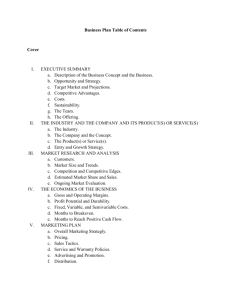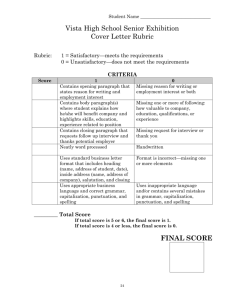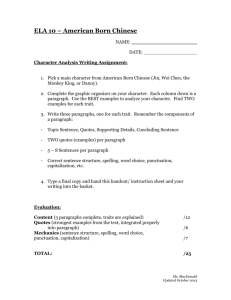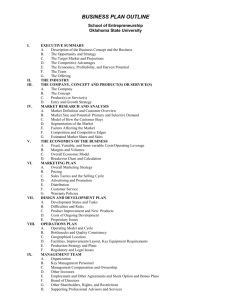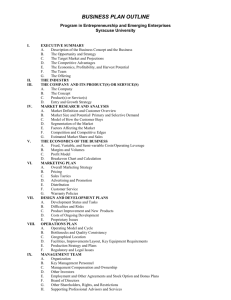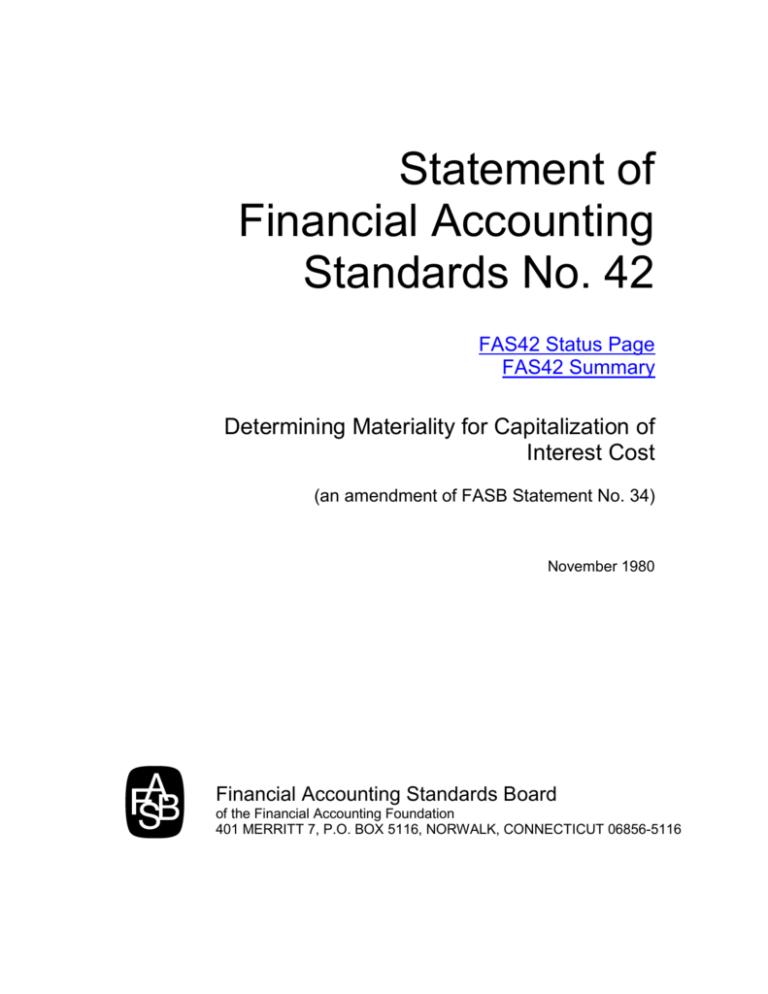
Statement of
Financial Accounting
Standards No. 42
FAS42 Status Page
FAS42 Summary
Determining Materiality for Capitalization of
Interest Cost
(an amendment of FASB Statement No. 34)
November 1980
Financial Accounting Standards Board
of the Financial Accounting Foundation
401 MERRITT 7, P.O. BOX 5116, NORWALK, CONNECTICUT 06856-5116
Copyright © 1980 by Financial Accounting Standards Board. All rights reserved. No
part of this publication may be reproduced, stored in a retrieval system, or transmitted, in
any form or by any means, electronic, mechanical, photocopying, recording, or
otherwise, without the prior written permission of the Financial Accounting Standards
Board.
Page 2
Statement of Financial Accounting Standards No. 42
Determining Materiality for
Capitalization of Interest Cost
an amendment of FASB Statement No. 34
November 1980
CONTENTS
Paragraph
Numbers
Introduction ................................................................................................................. 1– 3
Standards of Financial Accounting and Reporting:
Amendment to FASB Statement No. 34 .................................................................... 4
Effective Date and Transition..................................................................................... 5
Appendix A: Background and Basis for Conclusions............................................... 6–11
Page 3
FAS 42: Determining Materiality for Capitalization of Interest Cost
an amendment to FASB Statement No. 34
FAS 42 Summary
This Statement amends FASB Statement No. 34, Capitalization of Interest Cost, (1) to delete language
that some believe allows capitalization of interest to be avoided under certain circumstances and (2) to make
clear that Statement 34 does not establish new tests of materiality.
INTRODUCTION
1.
Paragraph 8 of FASB Statement No. 34, Capitalization of Interest Cost, states that:
In concept, interest cost is capitalizable for all assets that require a period of time to get them
ready for their intended use (an "acquisition period"). However, in many cases, the benefit in
terms of information about enterprise resources and earnings may not justify the additional
accounting and administrative cost involved in providing the information. The benefit may be
less than the cost because the effect of interest capitalization and its subsequent amortization or
other disposition, compared with the effect of charging it to expense when incurred, would not be
material. In that circumstance, interest capitalization is not required by this Statement.
Paragraph 9 of Statement 34 begins as follows:
Subject to the provisions of paragraph 8, interest shall be capitalized for the following types
of assets ("qualifying assets"). . ..
2.
The Board has received a number of questions concerning how paragraph 8 should be construed in
deciding whether capitalization of interest is required. Some have stated that paragraph 8 appears to establish
new tests of materiality that allow an enterprise to measure the effect of interest capitalization on income by a
pro forma prospective or retroactive computation without also considering the effect on current year income.
The Board has concluded that new tests of materiality should not be established for interest capitalization and
Copyright © 1980, Financial Accounting Standards Board
Not for redistribution
Page 4
has, accordingly, decided to amend paragraph 8 of Statement 34 to delete the language that gave rise to those
questions.
3.
The Board has concluded that it can reach an informed decision on the basis of existing information
without a public hearing and that the effective date and transition specified in paragraph 5 are advisable in the
circumstances.
STANDARDS OF FINANCIAL ACCOUNTING AND REPORTING
Amendment to FASB Statement No. 34
4.
The last two sentences of paragraph 8 of Statement 34 are superseded and replaced by the following
sentence:
Accordingly, interest shall not be capitalized in the situations described in paragraph 10.
The introduction of paragraph 9 of Statement 34 is amended to read as follows:
Interest shall be capitalized for the following types of assets ("qualifying assets"):
Effective Date and Transition
5.
This Statement shall be effective for fiscal years beginning after December 15, 1979. The provisions of
this Statement shall be applied at the same time as the provisions of Statement 34 are first applied. Enterprises
that already have adopted the provisions of Statement 34 shall apply the provisions of this Statement in their
next fiscal year beginning after October 15, 1980 and may, but are not required to, restate their financial
statements for the year of initial adoption to reflect the provisions of this Statement.
The provisions of this Statement need
not be applied to immaterial items.
This Statement was adopted by the affirmative votes of five members of the Financial Accounting
Standards Board. Messrs. March and Mosso dissented.
Messrs. March and Mosso dissent. They believe Statement 34 wisely introduced some flexibility to
minimize the additional cost of implementing a new accounting procedure for many enterprises. They would
not change the provisions or intent of paragraphs 8 and 9 of that Statement and would interpret it to permit the
use of evaluations like the pro forma approaches described in paragraph 6 of this Statement in assessing
materiality from a cost-benefit standpoint. In their view, the incremental gain in informational value from a
Copyright © 1980, Financial Accounting Standards Board
Not for redistribution
Page 5
requirement to capitalize interest on construction programs of a continuing level of activity involving many
asset items may be insufficient to offset the accounting costs that would in many instances be involved.
Although this Statement acknowledges the appropriateness of minimum threshold policies, Messrs.
March and Mosso would interpret Statement 34 as originally issued to permit a broader application of the same
reasoning that supported the exclusion of routinely manufactured inventories as qualifying assets in paragraph
10 of Statement 34. Judgments on such cost-benefit evaluations should be left to those able to examine specific
facts and circumstances.
Members of the Financial Accounting Standards Board:
Donald J. Kirk, Chairman
Frank E. Block
John W. March
Robert A. Morgan
David Mosso
Robert T. Sprouse
Ralph E. Walters
Appendix A: BACKGROUND AND BASIS FOR CONCLUSIONS
6.
The Board received a number of questions concerning how paragraph 8 of Statement 34 should be
construed in deciding whether capitalization of interest is required. Some asked whether capitalization is
required if a pro forma prospective computation indicates that equilibrium between the amount of interest
capitalized and amortized each period would be reached after a few years. If equilibrium would be reached
ultimately, those favoring this approach believe the benefits perceived by the Board for interest capitalization
would be small compared with the accounting and administrative costs involved in providing the information.
Others inquired if paragraph 8 would permit an enterprise to make pro forma computations of (a) the effect that
capitalizing interest in prior years and subsequently amortizing it would have on the level of earnings in the
current year and on the trend of earnings of preceding, current, and future years and (b) the effect of always
expensing interest on the level of earnings in the current year and on the trend of earnings over those years.
Under that pro forma retroactive approach, they believe an enterprise would not be required to capitalize interest
if a comparison of the computations showed no material difference in the effect on the current year's earnings or
in the effect on the trend of earnings.
7.
An Exposure Draft of a proposed Statement, Determining Materiality for Capitalization of Interest Cost,
was issued on April 22, 1980. The Board received 63 letters of comment in response to the Exposure Draft.
The Exposure Draft concluded that the pro forma prospective approach should not be adopted in Statement 34
because it focuses on expectations of future activities and developments rather than on measurement and
reporting of current earnings from past events and transactions. The Exposure Draft also concluded that the pro
forma retroactive approach should not be adopted because, among other reasons, the computations focus on
avoiding the requirements of the Statement while at the same time incurring the costs of calculation. The
Copyright © 1980, Financial Accounting Standards Board
Not for redistribution
Page 6
Board, therefore, concluded that the usual materiality tests are sufficient for implementation of Statement 34.
Some respondents stated that the views expressed above in paragraph 6 are consistent with the usual materiality
tests. However, the Board believes those views are not consistent with the usual materiality tests for the reasons
explained below in paragraphs 8 and 9.
8.
The usual tests of materiality for accounting changes are set forth in APB Opinion No. 20, Accounting
Changes. Paragraph 38 of Opinion 20 requires disclosure of an accounting change that has a material effect on
income before extraordinary items or net income of the current period. In addition, paragraph 38 requires
disclosure of an accounting change that has a material effect on the enterprise's trend of earnings. The views
expressed in paragraph 6 suggest that interest capitalization should not be required if the effect is material in the
current year but immaterial to the trend of earnings because of the "roll-over" effect that would occur from
amortizing previously capitalized interest. In effect, those views imply that immateriality to the trend of
earnings in the future should negate materiality to the current year income statement. Opinion 20, however,
requires determining the effect on the trend of earnings to provide disclosure of an accounting change that
would otherwise not be disclosed because of its immaterial effect on current period income, not to eliminate
disclosure of an accounting change for which disclosure would otherwise be required. In other words, the test
of the effect on trend of earnings is an additional test of materiality that increases the probability that an
accounting change will be deemed material.
9.
Consistent with the approach of Opinion 20, pro forma retroactive or prospective computations might be
used as part of the assessment of materiality to income in implementing Statement 34 but not as the overriding
test of materiality. If the effect of capitalizing interest on current year income is not material, an enterprise
might wish to use a pro forma prospective computation to determine whether the effect is likely to be material in
future years. Likewise, if the effect of capitalizing interest on current year income is only marginally material, a
pro forma prospective computation indicating that the effect will not be material in future years could aid a
determination that the current effect is not material. Pro forma retroactive and prospective computations can
confirm whether the effect of capitalizing interest is or is not material, but immateriality on a pro forma
retroactive or prospective test does not override a determination that an accounting change is material to current
year income, the balance sheet, or other measures.
10. Some respondents expressed concern that paragraphs 5 and 6 of the Exposure Draft indicated that the
Board opposes the use of minimum threshold levels in implementing Statement 34. That is not the case.
Minimum threshold levels are common in inventory and property, plant, and equipment accounting. Many
enterprises do not include the costs of minor items in inventory, and many enterprises do not capitalize
individual items of property, plant, and equipment, the costs of which are less than a specified threshold. Such
thresholds are designed to minimize the burden of capitalizing large numbers of assets and accounting for those
costs as the assets are used. Those thresholds are justified on the grounds that the assets whose costs are
charged to expense as purchased are immaterial both individually and in the aggregate. This Statement affirms
the usual tests of materiality and does not affect threshold levels established in conformity with usual materiality
tests.
11.
Some respondents stated that the transition provisions did not address those enterprises that had elected
Copyright © 1980, Financial Accounting Standards Board
Not for redistribution
Page 7
early application of Statement 34 and might believe they were exempt from the provisions of this Statement.
The Board intended that this Statement should apply to those enterprises and has clarified paragraph 5 to state
that those who elected early application of Statement 34 are subject to the provisions of this Statement in the
future. Those enterprises may, but are not required to, restate financial statements to the year of initial adoption
of Statement 34.
Copyright © 1980, Financial Accounting Standards Board
Not for redistribution
Page 8

